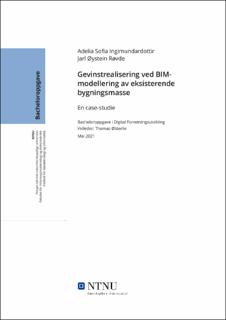| dc.contributor.advisor | Østerlie, Thomas | |
| dc.contributor.author | Ingimundardottir, Adelia Sofia | |
| dc.contributor.author | Røvde, Jarl Øystein | |
| dc.date.accessioned | 2021-09-15T16:38:44Z | |
| dc.date.available | 2021-09-15T16:38:44Z | |
| dc.date.issued | 2021 | |
| dc.identifier | no.ntnu:inspera:83511437:83539794 | |
| dc.identifier.uri | https://hdl.handle.net/11250/2778027 | |
| dc.description.abstract | Til tross for stort fokus på digitalisering, har BAE- (bygg, anlegg og eiendom) næringen ikke opplevd produktivitetsvekst. På samme tid opplever andre fastlandsnæringer økning i produktivitet som en konsekvens av digitalisering. Ifølge en NOU-rapport fra 2010, vil 80% av bygningsmassen som eksisterer i Norge i dag, fremdeles være i bruk i 2050.
Med økt fokus på digitalisering og digital transformasjon i bransjen, har potensialet for effektivisering og gevinstrealisering innen modellering av eksisterende bygningsmasse vokst. Innen planlegging og oppføring av nye bygg, er BIM et verktøy som har blitt brukt i flere år.
I eksisterende bygningsmasse har BIM derimot ikke vært like mye bruk, men nå skjer det en økning i bruken av teknologien. Innføring av BIM i eksisterende bygningsmasse åpner opp for en rekke gevinster knyttet opp mot økonomi, bærekraft, sikkerhet og teknologi. Allikevel er arbeidet med gevinstrealisering svært krevende. I denne oppgaven vil vi belyse hvordan gevinster ved BIM i eksisterende bygningsmasse kan realiseres.
Oppgaven tar et utgangspunkt i en casestudie som bygger på et renoveringsprosjekt der BIM står sentralt. Casestudien baserer seg på kvalitative data fra semistrukturerte intervjuer, samt en spørreundersøkelse for å forsterke funnene i intervjuene. I tillegg blir teori og eksisterende empiri brukt som grunnlag for å besvare problemstillingen. Funnene fra intervjuene ble brukt for å innhente erfaringer og kunnskaper om tema hvor det foreligger lite konkret informasjon. Gjennom forskningsarbeidet kommer det fram at BIM er noe alle byggherrer kan dra nytte av, men at det krever målrettet og koordinert arbeid innenfor gevinstrealisering, endringsledelse og teknologiakseptanse. | |
| dc.description.abstract | Despite of a great focus on digitalisation, the construction industry of Norway has experienced little to no productivity growth over the past years. Meanwhile, other main land industries of Norway are experiencing and increase in productivity as a consequence of digitalisation. According to a NOU-report from 2010, 80% of existing structures in Norway will still be in use by 2050.
With an increased focus on digitalisation and digital transformation, the potential for efficiency and benefit realization within modeling existing structures has grown. Within planning and constructing of new buildings, BIM has been a standard tool for many years. Even though BIM has been little used in existing structures, we now see an increase in the use of the technology. Implementation of BIM in existing construction mass opens for new benefits within, among others, economy, sustainability, safety, and technology. Still, it is not always clear how these benefits attached to implementation of BIM in existing construction mass can be realised. In this thesis we will enlighten how benefits from BIM in existing construction mass can be realized.
The thesis is based on a case study of a renovation project where BIM plays an important role. The case study is based on qualitative data from semi-structured interviews. In addition we made a survey to strengthen claims from the interviews. Furthermore, theory and empirical data are used as a basis to answer the current problem. The findings from the interviews were used to gain experience and knowledge on topics where there is little concrete information. Through the research, emerges a basis to conclude that BIM is a tool most landlords can benefit from. However, BIM requires targeted, and coordinated work within benefit realization, change management as well as technology acceptance. | |
| dc.language | nob | |
| dc.publisher | NTNU | |
| dc.title | Gevinstrealisering ved BIM-modellering av eksisterende bygningsmasse: En case-studie | |
| dc.type | Bachelor thesis | |
